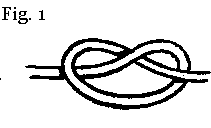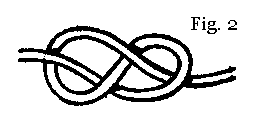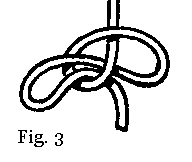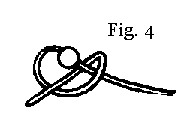Like most things in lutherie, attaching the strings to the instrument is straightforward, once a few descriptions of the process are given. Let’s begin with the situation of a soprano ukulele. The bridge is usually a simple affair, with a slot for each string and some sort of knot hole or ledge at the base of the string slot.
If the diameter of the string is very close to the width of the string slot, then a simple overhand knot will do to keep the string from pulling through. Figure 1 shows this knot.


If you trim the knot such that there is ~ 1/4″ left sticking out and melt most of that into a little ball, then you have a little extra insurance to prevent the knot from slipping. If the string diameter is smaller than the slot then the knot must be made larger to prevent its slipping through the string slot. Figures 2 and 3 show larger knots which I have seen and used for this purpose. In both cases adding the little melted ball on the end of the string is still useful.


When it comes to tying the string to the tuner, a slightly different knot has worked well for me. Figure 4 shows a view of this knot from the top. The string comes from the bridge, through the tuner hole, turns toward the middle of the headstock, comes around and over (and then under) the string coming from the bridge. So it looks a little like the overhand knot in Figure 1. The string is pulled so that there is very little slack between the tuner and the bridge, and the tuner tightened so that the string tension will hold the string against the loop. For tuners on the right hand side of the headstock, the tuners should be turned in a clockwise direction; tuners on the left hand side should be turned in a counter clockwise direction.
The string should be wound downwards from where it enters the tuner hole. From the side, the string will now look like a candy cane or barber pole as it winds down the string post. It’s best if by the time the instrument is tuned, that there are only two or three turns on the tuner peg. More turns will cause slippage and the instrument will be hard to keep in tune. It’s also best if the string is nearly at the face of the headstock when it’s fully stretched in so that the string angle from the nut to the tuner is maximized. A greater string angle here will press the string more firmly into the nut slot and reduce the likelihood of buzzing.
(To be continued for the tenor and baritone bridges…)
I enjoy writing these pages and hope that they are interesting and useful to the reader. I’ve stopped building at this time and still need to generate some income in order to continue to expand this website with more useful articles. If this page was helpful to you and you would like to make a $10.00 donation in order to have more pages like it, please use the donation button below. Thank you.